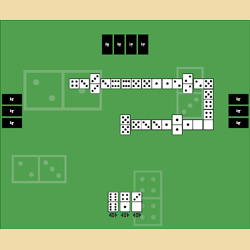|
 |
Description
Domino set consists of 28 rectangular pieces, usually in white face and black reverse. The face is split in two squares; each of the squares may be empty (called white) or filled with a variable amount of points that range from 1 to 6 (though some games use up to 9 or 12 points).
The pieces cover all the possible combinations with both numbers. So, there are 7 different pieces with each of the numbers. Pieces where the number is repeated are called doubles. The value of every piece is the sum of the points in both squares.
Rather than an specific game, the word domino refers to a whole family of games that may be practised with those pieces.
Usually the goal of the game for every player entails in placing all the pieces into a chain where pieces are linked using squares with the same number.
The domino game offered by Ludoteka.com is the more usual in Spain, and it opposites two pair of players. There are some rules that vary depending on the place where it is played; the rules used comply with those describe by the Domino Spanish Federation
Objective
The objective is to reach the score agreed before the start of the game. 300 points is a usual goal.
How the game goes on
Usually several rounds must be played to reach the necessary amount of points. Next, here is the explanation about how those rounds must be played.
Start of the game
Players of both pairs are placed in alternate positions.
First, randomly must be decided who will be the leader; every player takes one piece, and the highest is the winner; if there is a draw, the highest square is used.
All the pieces are dealed in every round (7 for each player). If somebody receives more than 3 doubles, it is repeated.
Placing the pieces
The leader can place any piece on the table. Next, counter-clockwise, every player links one piece in the chain whenever it is possible; otherwise, he must pass.
Pieces form a chain where similar squares are put together, except doubles, that are placed perpendicular to the rest of the pieces.
Forced moves
When there is one only possible move, the player who moves should not delay, giving a deceptive information to the opponents.
In those cases, the program gives to the player 3 seconds to make the move; when this time is passed, the move is made automatically.
Final
The round may finish for two different reasons:
- When one of the players places all the pieces: the correspondig pair wins the round.
- When it gets blocked: all the players keep any piece in their hands, but none of them can place any more. In this case the sum of all the points of the remaining pieces are counted for both pairs, and the winner is the pair whose sum is lower. If it is a draw, the round doesn´t alter the score.
In all the cases, the winning pair gets the sum of the points of all the remaining pieces that have not been placed in the chain.
In next hands the leader will be the player placed on the right of the previous one.
The game is won by the pair that reaches the score selected when the game was opened.
Individual variant
Domino may be played individually. The main rules of the individual domino are the same as playing by pairs, but in practice the strategies may become very different.
The complete information is in the individual domino rules page.
Play now
Play online with some other players
Related links
Jeux & Stratégie - Les Dominos
Copyright © 2001-2025 Ludoteka.com Jokosare S.L. All rights reserved - Disclaimer - Cookies - Contact
